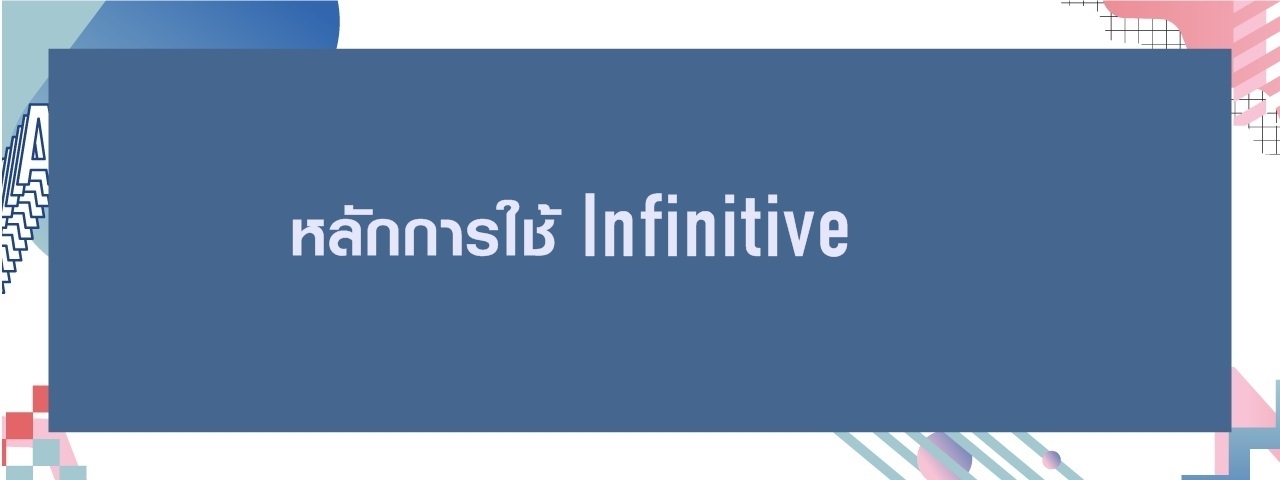

 557,880 Views
557,880 ViewsInfinitive with to คือ คำกริยาช่อง 1 ที่มี to นำหน้า เช่น
to talk
to think
to sleep
to watch
to have
1. ทำหน้าที่เป็นคำนามซึ่งเป็นประธานของประโยค เช่น
To learn is important.
(การเรียนเป็นสิ่งสำคัญ)
To listen English music is a good way to learn English.
(การฟังเพลงภาษาอังกฤษเป็นหนึ่งวิธีที่ดีในการเรียนภาษาอังกฤษ)
2. ใช้ตามหลังคำกริยาแท้ (Main Verb) โดยทำหน้าที่เป็นกรรมของประโยค เช่น
She wants to learn Italian.
(เขาต้องการเรียนภาษาอิตาลี)
Chanatip loves to play football.
(ชนาธิปชอบเล่นฟุตบอล)
3. ใช้ตามหลังคำคุณศัพท์ (Adjective) บางคำ ทำหน้าที่เป็นเหมือนคำกริยาวิเศษณ์ (Adverb) เพื่อเป็นการบอกเหตุผล เช่น
|
able |
anxious |
disappointed |
|
due |
eager |
glad |
|
happy |
keen |
likely |
|
lucky |
pleased |
prepared |
|
proud |
ready |
sad |
|
surprised |
unable |
unhappy |
|
unlikely |
unwilling |
willing |
ตัวอย่างประโยค
She is lucky to have such good friends.
(เธอโชคดีที่มีเพื่อนดี ๆ มากมาย)
I’m proud to work with you
(ฉันภูมิใจที่ได้ทำงานกับคุณ)
และใช้ตามหลังคำคุณศัพท์เหล่านี้เพื่อให้ความคิดเห็น
|
clever |
difficult |
easy |
|
foolish |
hard |
impossible |
|
kind |
nice |
possible |
|
right |
silly |
wrong |
ตัวอย่างประโยค
It’s easy to sing the song, but it’s very difficult to sing well.
(มันง่ายที่จะร้องเพลง แต่มันยากมากที่จะร้องให้ไพเราะ)
It was foolish of him to trespass against the law.
(มันเป็นความโง่ของเขา ที่ละเมิดกฎหมาย)
4. ใช้ตามหลังคำนามหรือสรรพนาม โดยทำหน้าที่เป็นเหมือนคำคุณศัพท์ (Adjective) ขยายคำนามหรือสรรพนามนั้น เช่น
I have some jeans to wash.
(ฉันมีกางเกงยีนที่จะซัก)
The singer to watch is Ed Sheeran.
(นักร้องที่ดูอยู่คือ เอ็ด ชีแรน)
5. ใช้แสดงเป้าหมาย, วัตถุประสงค์ หรือใช้ในการตอบคำถาม ‘Why?’ เช่น
Prawit bought a gorgeous watch to give to his girlfriend.
(ประวิทย์ซื้อนาฬิกาสุดหรูเพื่อให้แก่แฟนสาวของเขา)
I went to Nui’s house to do our report.
(ฉันไปบ้านของนุ้ยเพื่อทำรายงานของพวกเรา)
เราใช้วลี ‘in order to’ (เพื่อที่จะ...) หรือ ‘in order not to’ (เพื่อที่จะได้ไม่...) ในการอธิบายวัตถุประสงค์ เช่น I save money in order to buy the car. (ฉันเก็บเงินเพื่อที่จะซื้อรถ) ซึ่ง Infinitive with to สามารถใช้ในความหมาย ‘in order to’ ได้ เช่น
She wears high-heeled shoes to look taller. = She wears high-heeled shoes in order to look taller.
(เธอสวมรองเท้าส้นสูงเพื่อที่จะให้ดูสูงขึ้น)
1. มักใช้ตามหลังคำกริยาเหล่านี้ ในโครงสร้าง Subject + Verb + Infinitive with to
|
afford |
agree |
appear |
|
arrange |
ask |
attempt |
|
begin |
can’t bear |
can’t stand |
|
care |
cease |
choose |
|
claim |
continue |
decide |
|
demand |
deserve |
determine |
|
dread |
expect |
fail |
|
forget |
get (be allowed to) |
happen |
|
hate |
hesitate |
hope |
|
hurry |
intend |
learn |
|
like |
love |
manage |
|
need |
neglect |
offer |
|
plan |
prefer |
prepare |
|
pretend |
promise |
propose |
|
prove |
rail |
refuse |
|
regret |
remember |
seem |
|
start |
swear |
tend |
|
threaten |
try |
vow |
|
wait |
want |
wish |
|
would like |
yearn |
|
ตัวอย่างประโยค
We agreed to work together.
(พวกเราตกลงทำงานด้วยกัน)
I forgot to close the window.
(ฉันลืมปิดหน้าต่าง)
2. คำกริยาบางตัวตามด้วยกรรมตรง (Direct Objects) และ Infinitive with to ในโครงสร้าง Subject + Verb + Object + Infinitive with to
|
advise |
allow |
ask |
|
cause |
challenge |
command |
|
encourage |
expect |
force |
|
get |
instruct |
intend |
|
invite |
lead |
order |
|
persuade |
remind |
teach |
|
tell |
urge |
want |
|
warn |
would like |
would prefer |
ตัวอย่างประโยค
He ask me to explain.
(เขาขอให้ฉันอธิบาย)
I encouraged my sister to learn Japanese.
(ฉันสนับสนุนน้องสาวของฉันให้เรียนภาษาญี่ปุ่น)
3. ใช้ตามหลังคำว่า ought (ควรจะ), get used (เคยชิน) และ used (เคย) เช่น
You ought to do this project by yourself.
(คุณควรจะทำโปรเจ็กนี้ด้วยตัวคุณเองนะ)
They get used to live in country.
(พวกเขาเคยชินกับการอาศัยอยู่ในชนบท)
I used to learn Italian 10 years ago.
(ฉันเคยเรียนภาษาอิตาลี 10 ปีมาแล้ว)
4. ใช้ Verb to be + Infinitive with to (V.to be + V.1) หรือ have + Infinitive with to (have to + V.1) ในความหมายว่า ต้อง... เมื่อต้องการออกคำสั่งหรือขอร้อง เช่น
You are to go now.
(คุณต้องไปเดี๋ยวนี้)
In France, you have to drive on the right.
(ในฝรั่งเศสคุณต้องขับรถทางขวา)
5. เมื่อทำเป็นรูปปฏิเสธ เพียงเติม not ข้างหน้า to เช่น
We decided not to go out tonight.
(พวกเราตัดสินใจไม่ออกไปข้างนอกคืนนี้)
It’s better not to smoke.
(ไม่สูบบุหรี่มันจะดีกว่านะ)
Infinitive without to คือคำกริยาช่อง 1 ที่ไม่มี to นำหน้า มีหลักการใช้ดังนี้
1. ทำหน้าที่เป็นคำกริยาหลัก (Main Verb) โดยใช้ตามหลังกริยาช่วย (Auxiliary Verb) verb to do หรือ Modal Verb (will, shall, would, should, can, could, may, might, must) เช่น
I can play the guitar.
(ฉันสามารถเล่นกีตาร์ได้)
Tom will go to London next week.
(ทอมจะไปลอนดอนสัปดาห์หน้า)
2. ใช้ตามหลังคำกริยาอื่น ๆ ทั่วไปหรือเรียกว่า Special Verb ที่มีกรรมตรง (Direct Object) และคำกริยาที่แสดงถึงการยินยอมหรือให้เหตุผล เช่น watch, see, feel, hear, help, let, make, see เช่น
I watched them bake the bread.
(ฉันดูพวกเขาอบขนมปัง)
watch = Special Verb
bake = Infinitive without to
them – Direct Object
He saw his wife slap the child.
(เขาเห็นภรรยาของเขาตบลูก)
saw = Special Verb
slap = Infinitive without to
his wife = Direct Object
3. ใช้ตามหลังคำเหล่านี้ had better, need, dare, would rather, would sooner, rather than, but, and, or, except เช่น
They had better be here before we start dinner.
(พวกเขาควรอยู่ที่นี่จะดีกว่าก่อนที่พวกเราจะเริ่มดินเนอร์)
be = Infinitive without to
You need not wait.
(คุณไม่จำเป็นต้องรอ)
wait = Infinitive without to
